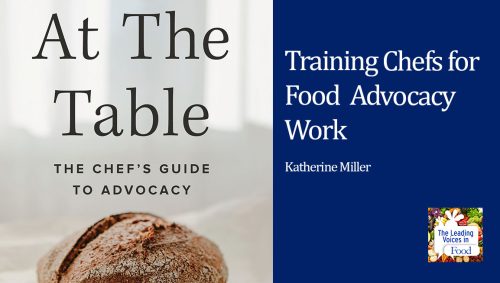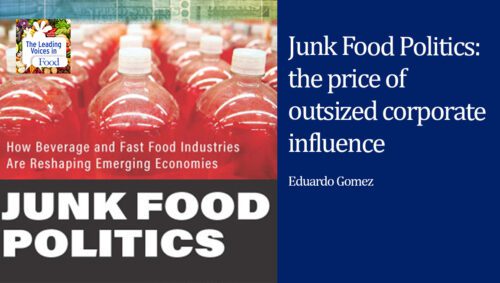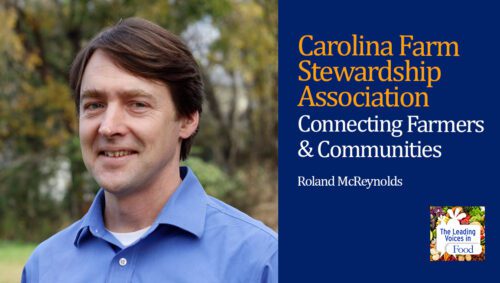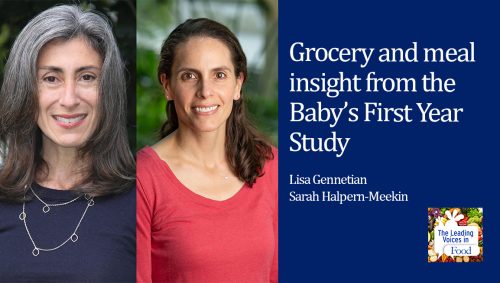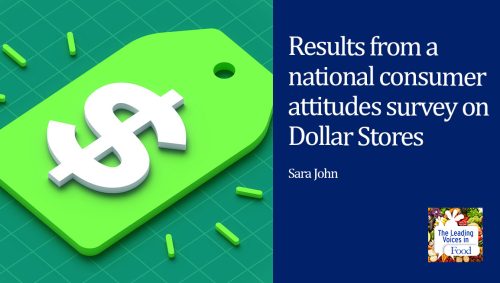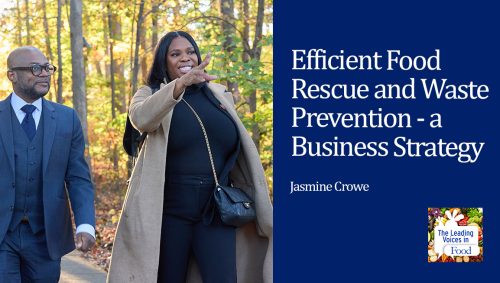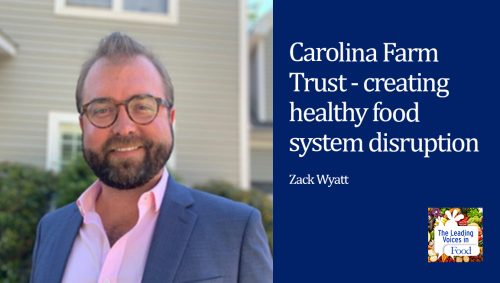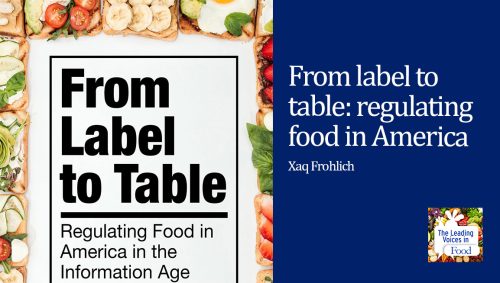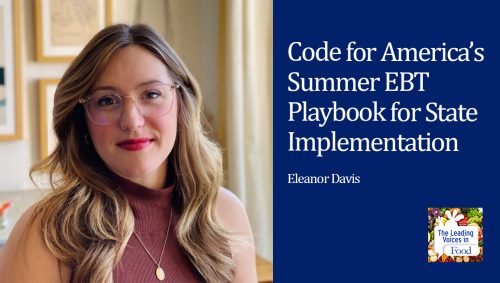E98: The COVID-19 Pandemic Response of No Kid Hungry
This podcast is part of a series focused on the far-reaching impact of the COVID-19 pandemic on the food system. Today we’re looking at how responses to the pandemic have affected food availability and nutrition for one of America’s most vulnerable populations – young children. Joining me is Eleni Towns, the Associate Director of the No Kid Hungry Campaign at Share Our Strength.
Subscribe: Apple Podcasts | TuneIN | Google Podcasts | SoundCloud | PocketCasts | Radio Public
Tags: Advocacy & Food | COVID-19 Pandemic Impacts on Food | Diet & Nutrition | Food Banks, Food Pantries & Soup Kitchens | Food Insecurity | Food Policy | Philanthropy & Food Systems | Social Safety Net & Food |

Eleni Towns is an Associate Director of the No Kid Hungry Campaign at Share Our Strength. The campaign was launched in 2010 and aims to end child hunger by increasing participation in federal nutrition programs. In this capacity, Eleni manages a portfolio on No Kid Hungry state campaigns and has most recently led the organization’s work in Georgia, Tennessee, Ohio, Alabama, and Pennsylvania, working with state agencies, school districts, and nonprofit partners. Prior to Share Our Strength, Eleni has worked as a policy analyst at Feeding America and Center for American Progress.
Interview Summary
Eleni, before we dive into questions about COVID-19 and children, could you help our listeners understand better the work of the No Kid Hungry Campaign overall?
Sure. The No Kid Hungry Campaign is a campaign of Share Our Strength, a national nonprofit. And we’re working to ensure that kids in the country have the food they need. We do a lot of work through access to the federal nutrition programs because we know there’s significant barriers between families and the programs that can help them. And we work to make sure they have access to the support they need so that they can have the nutrition and the health that they deserve. We believe that hunger is a solvable problem in America. So that’s our guiding principle and mission of the campaign.
So COVID-19 is not just a health crisis, but it’s really ripped a hole in the American economy. So what impacts that had on children?
Unfortunately, childhood hunger was a problem long before this crisis, but we’ve seen that exacerbated the need and also made it far more visible. You know, last year our country saw the lowest food insecurity rate since before the Great Recession. And then the pandemic hit and really undid a decade’s worth of progress in child food insecurity. And the scale of that change is astronomical. Previous numbers from a few months ago showed that as many as 14 million children in the U.S. are missing meals and not getting enough to eat. That’s five times higher than the numbers reported this time last year. So numbers are continuing to come in, but we know that this is still a crisis today. We also know that this is a problem that won’t easily go away on its own. As communities open and then close back again, as industries face the long-standing impacts of this economic crisis, we’re seeing millions of lost jobs and lower wages. We have families that are facing both poverty and hunger for the first time and having to navigate the federal nutrition programs and support systems. And then we’re also seeing those families that were already facing poverty and food insecurity fall into greater hardship and even farther behind.
Five times the rates of food insecurity – and that’s just taken place in less than a year – is really a pretty striking number. So of course with the economy in such tough shape and given the numbers that you just talked about, many families are having a very tough time affording food, and of course food banks are there to help, but are there other programs that can be helpful as well?
Yes, even in this crisis, we still believe childhood hunger is a solvable problem, and that’s because we can leverage this federal safety net and support system to help families and kids get the nutrition that they need. We think of the federal response more of a sort of network of supports that can meet different needs of a family depending on their dynamic, and can really ensure that no kid, no individual, slips through the cracks. I think of two programs I’d love to mention because they’re so critical in this response is SNAP and P-EBT. They both are great examples of how the programs work together effectively. As you may know, SNAP is the Nutritional Assistance Program and it provides families with the grocery benefit they can use to purchase food for themselves or their families. Pandemic EBT was developed in response to this crisis to provide a benefit to replace some of the meals children would have received from school, like their breakfast or lunch program if they were in school. So the programs work together to provide families that blended support that is needed. School meals is another critical resource for families during this crisis. These programs work together to support households depending on their makeup and the needs that they’ve been facing during this hard times.
And does it go without saying that additional support for these programs is very important?
Yes, it’s really critical. The need isn’t going away. As we get further along in this crisis, food insecurity rates are not decreasing and in some places only increasing, and to the scale that I said before really requires a federal response. So we have been advocating for additional benefits for the SNAP program. We advocated successfully for the continuation of the Pandemic EBT program. And so really thrilled to see that extension through the end of this school year.
If you could say there’s one thing that you wish more people knew about the issue of hunger in the U.S. what would that be?
I wish especially that our political leaders and local decision makers understood that food insecurity is more than a single instance of feeling hunger, right? We’ve all felt hunger in our lives. We know that sensation, it’s not an enjoyable one. And we know some of those impacts it can have on our day to day. But food insecurity is a much more lasting and harmful situation. And research really backs that up, especially among kids. Those that face insecurity can have long-term impact. Kid has trouble learning, paying attention in school. Insecurity and worry about where your next meal can come from can have emotional and traumatic instances for a kid about their feelings of safety and security. And we know from our health experts, that food insecurity is associated with poor health outcomes that exists not only in childhood, but beyond. Food insecurity is an immediate problem, but it’s one that if we don’t solve can have long lasting impacts.
Let’s speak a moment about school meals. You know, it’s such an important resource for kids in need, but with so many schools now going to virtual or hybrid schedules, how are kids getting these meals?
School meals are incredibly important. They always have been. It’s been a key piece of our work here at the No Kid Hungry Campaign, and with the increased need and the uncertainty that the school year has brought, we think it’s more important than ever. It’s been a real challenge, and I think the school districts and the new school nutrition departments that have been running these programs in new ways since school’s closed in March, are the unsung heroes of this pandemic. They have done phenomenal work working through a health and an economic crisis to meet families with the meals that they need. And they face a lot of challenges this fall as school has returned.
We know that school meals are important for kids to learn, and so that’s important whether they’re in the building or if they’re learning remotely. And so many school districts have these hybrid or these complicated models of some kids being in school at different hours, different days, some being at home. And so that’s really required school districts to come up with innovative solutions, which often requires more staff time, different technology, transportation systems. School districts are offering grab and go meals for families to drive by and pick up. They are developing really robust transportation systems using their busing to work in reverse and send to meals from the school out to communities for families. So much of school meal programming is focused around a cafeteria, which in many schools does not align with social distancing needs. School nutrition departments have had to get really creative and thoughtful about how do you take meals outside of the cafeteria? How do you serve meals in the classroom? How do you make sure you have the labor and the food safety concerns in mind when you bring meals outside of the cafeteria and deliver into the classroom? So a lot of changing dynamics, a lot of additional barriers and challenges for them, but they’re doing phenomenal work to reach those kids.
Are there other things that No Kid Hungry is doing to make sure that kids are fed?
Yes, I think the school meals, as I mentioned, is a key piece of the response. Also charitable support is critical. Since March, we have granted to over 1,200 organizations to help with their response. We distributed 32 million in funding that went to schools, to food banks, to other community-based organizations. And we’re actually going to be providing an additional 29 million before the end of the school year. And really the granting system is to help schools or community organizations buy the equipment that they need, the safety resources, the transportation, whatever is needed to really make sure they keep their staff and the communities they are aiming to serve healthy and meeting them where they’re at. But in addition to funds, we’re working across the whole spectrum of the federal response. So how can we both advocate for federal programs and the changes that might be needed during this time, as well as provide technical assistance to providers so that they can do everything in their power in this changing dynamic to support their communities. So we engage elected officials about what they can do to support families facing food insecurity, raising awareness among the public about the problem and the need to take action, getting information and resources out to families so they know where they can get the support that they need. It’s a critical problem, it’s all hands on deck.
All the work is going on with policies and practices at the federal and local levels is really very impressive. Let me ask about next steps. So what do you think are the best next steps that the nation can take to better safeguard children against hunger and malnutrition?
For all of us, I think there’s a piece about raising awareness. We often don’t think of hunger as an issue in America because we have such plenty here, but in terms of the federal response, what we’ve been really working towards and support moving forward is making sure we have robust programs. So I’ve mentioned the SNAP program is a really critical response, but we believe more benefits are needed for families during this time. So in urging Congress to take action, to support an additional stimulus bill so that families have the benefits and resources they need, as well as other key programs, the WIC program, we talked about school meals, really making sure that these systems are able to expand in a moment of crisis, which we are in, is critical.


